This article needs additional citations for verification .(January 2015) |
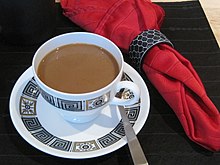 Coffee with whitener |
White coffee can refer to any of a number of different kinds of coffees or coffee substitutes worldwide.
This article needs additional citations for verification .(January 2015) |
 Coffee with whitener |
White coffee can refer to any of a number of different kinds of coffees or coffee substitutes worldwide.
In many English-speaking countries, "white coffee" is used to refer to regular black coffee that has had milk, cream or some other "whitener" added to it, though the term is almost entirely unheard of in the US, where the same beverage might be called "coffee light" in the New York City area, "light coffee", "coffee with milk," or "regular coffee" in New England and New York City. [1] [ failed verification ][ circular reference ]Cream varieties, often called "creamers" in the US, can be made of dairy milk, corn syrup derivatives, soy, or nut products. Sweeteners used include cane sugar, honey, or artificial ingredients.
White coffee should be distinguished from café au lait, in that white coffee uses chilled or room-temperature milk or other whitener, while café au lait uses heated or steamed milk.
In Malaysia, the original white coffee started in the Old Town of Ipoh and was a drink made from beans roasted in margarine, ground, brewed and served with sweetened condensed milk. Ipoh Oldtown White Coffee continues to be popular throughout the country.
Overseas visitors finding the margarine-roasted coffee beans unorthodox (due to their slight caramelized flavor) are often misled into believing that there is a type of coffee bean endemic to Malaysia called the "white coffee bean". The beans used are invariably imported beans roasted to a light color.
Local coffee manufacturers now mix instant coffee powder with non-dairy creamer or whitener and sugar, and market the 3-in-1 mixture as white coffee as well. The mixture is preferred by Malaysians at home or in the office as a convenient easy-to-prepare coffee drink. The advisability, however, of consuming instant coffee mixed with non-dairy creamer and sugar daily is slowly coming into question, with some manufacturers now taking the sugar out of the mixture, and marketing the 2-in-1 mixture as sugar-free white coffee.
In Indonesia, the term white coffee or kopi putih refers to coffee beans which are roasted less than regular coffee beans. The shorter and lower heat roasting yields lighter-colored coffee beans, called biji kopi putih or white coffee beans. The white coffee beans are harder and different in taste than regular coffee beans. White coffee has a savory and mild taste compared to its regular counterpart. Due to its shorter roasting time, white coffee has a higher concentration of caffeine. [2] [3]
Jordanian and Lebanese white coffee "qahwah bayda" (قهوة بيضاء) is a caffeine-free drink made from water, orange blossom water, and sweetened with sugar if desired, or rose water. Although not the most common substitute for coffee it is occasionally served in lieu of coffee (Turkish coffee). Ahweh bayda is traditionally thought to have a soothing effect when taken.
In the United States, white coffee may also refer to coffee beans which have been roasted to a yellow roast level. When prepared as espresso these beans produce a thin yellow brew, with a high acidic note. There is a debate about whether white coffee is more highly caffeinated than darker roasted coffee. In fact, the sublimation point of caffeine is 352 °F (178 °C), about one hundred degrees lower than the typical very dark roast. Coffee beans can catch fire at temperatures higher than 500 °F (260 °C). [4] [5] White coffee is generally used only for making espresso drinks, not simple brewed coffee. With shorter roasting times, natural sugars are not caramelized within the coffee beans, making the coffee less bitter. The flavor of white coffee is frequently described as nutlike, with pronounced acidity. White coffee is usually purchased pre-ground due to the fact that the beans are harder than regular coffee, making it difficult to grind, even using a commercial grinder. For this reason, white coffee usually pours fast when using a commercial espresso machine. It is common for baristas to use the second pour rather than the first because it is believed to have more caffeine and a smoother flavor.
There is also a form of white coffee, native to Yemen, which refers to the ground shell of the coffee bean. This form of coffee earns its name from its color, and is brewed in the same manner as regular coffee, only with some spices added.
The name kopitiam symbolizes Singapore's multilingual culture: "kopi" is Malay for coffee, while "tiam" is Hokkien (or Fukienese) for shop. Kopitiams are mainly open-air gatherings, with a few of food vendors on the first floor of the ubiquitous government-built housing complexes that span entire blocks. The basic kopi that results is a cup of thick coffee that has been squeezed through a cloth sock several inches long and is packed with tablespoons of sugar and sweet condensed milk. [6]

Espresso is one of the most popular coffee-brewing methods, of Italian origin. The French also made a significant contribution to the invention of the first coffee makers, predecessors of today's espresso machines, and generally to the café culture. Espresso can be made with a wide variety of coffee beans and roast degrees, in which a small amount of nearly boiling water is forced under pressure through finely-ground coffee beans. Espresso is the most common way of making coffee in southern Europe, especially in Italy, France, Spain, Portugal and Greece, but it is also popular in the rest of the world.

Instant coffee is a beverage derived from brewed coffee beans that enables people to quickly prepare hot coffee by adding hot water or milk to coffee solids in powdered or crystallized form and stirring. The product was first invented in Invercargill, the largest city in Southland, New Zealand, in 1890. Instant coffee solids refers to the dehydrated and packaged solids available at retail used to make instant coffee. Instant coffee solids are commercially prepared by either freeze-drying or spray drying, after which it can be rehydrated. Instant coffee in a concentrated liquid form, as a beverage, is also manufactured.

Caffè latte, often shortened to just latte in English, is a coffee drink of Italian origin made with espresso and steamed milk. Variants include the chocolate-flavored mocha or replacing the coffee with another beverage base such as masala chai, mate, matcha, turmeric or rooibos; alternatives to milk, such as soy milk or almond milk, are also used.
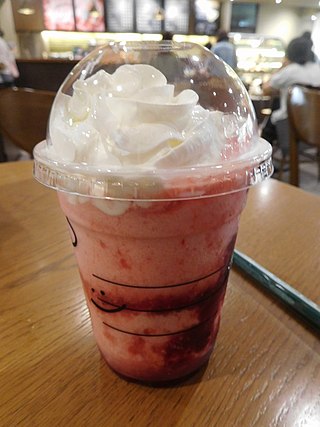
Frappuccino is a line of blended iced coffee drinks sold by Starbucks. It may consist of coffee or crème base, blended with ice and ingredients such as flavored syrups and usually topped with whipped cream and or spices. It may also include blended Starbucks refreshers. Frappuccinos are also sold as bottled coffee beverages in grocery stores, convenience stores and from vending machines.

Coffee is a beverage prepared from roasted coffee beans. Darkly colored, bitter, and slightly acidic, coffee has a stimulating effect on humans, primarily due to its caffeine content. It has the highest sales in the world market for hot drinks.

A caffeinated drink, or caffeinated beverage, is a drink that contains caffeine, a stimulant that is legal practically all over the world. Some are naturally caffeinated while others have caffeine added as an ingredient.
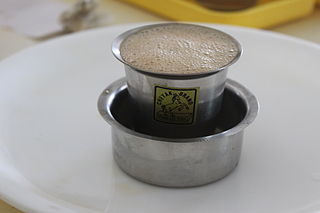
Indian filter coffee is a coffee drink made by mixing hot milk and sugar with the infusion obtained by percolation brewing of finely ground coffee powder with chicory in a traditional Indian filter. It has been described as "hot, strong, sweet and topped with bubbly froth" and is known as filter kaapi in India.

Café au lait is coffee with hot milk added. It differs from white coffee, which is coffee with cold milk or other whiteners added.
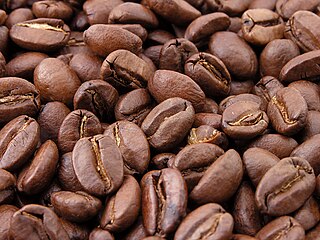
A coffee bean is a fruit from the Coffea plant and the source for coffee. It is the pip inside the red or purple fruit. This fruit is often referred to as a coffee cherry, and like the cherry, it is a stone fruit. Even though the coffee beans are not technically beans, they are referred to as such because of their resemblance to true beans. The fruits most commonly contain two stones with their flat sides together. A small percentage of cherries contain a single seed, instead of the usual two, called a "peaberry". The peaberry occurs only between 10% and 15% of the time, and it is a fairly common belief that they have more flavour than normal coffee beans. Like Brazil nuts and white rice, coffee beans consist mostly of endosperm.

A kopitiam or kopi tiam is a type of coffee shop mostly found in parts of Indonesia, Malaysia, Singapore, Brunei and Southern Thailand patronised for meals and beverages, and traditionally operated by the Chinese community of these countries. The word kopi is an Indonesian and Malay term for coffee and tiam is the Hokkien/Hakka term for shop. Menus typically feature simple offerings: a variety of foods based on egg, toast, kaya, plus coffee, tea, Horlicks and Milo.

Ipoh white coffee is a popular coffee drink which originated in Ipoh, Perak, Malaysia, resulting in Ipoh being named one of the top three coffee towns by Lonely Planet. The coffee beans are roasted with palm oil margarine, and the resulting coffee is served with condensed milk.

Teh tarik is a popular hot milk tea beverage most commonly found in restaurants, outdoor stalls, mamaks and kopitiams within the Southeast Asian countries of Malaysia, Indonesia, Singapore and Thailand. Its name is derived from the process of repeatedly pouring the drink back and forth from one container into another with arms extended during preparation, which helps to slightly cool the tea for consumption and giving it a frothy head. It is made from a strong brew of black tea blended with condensed milk. It is the national drink of Malaysia.

Roasting coffee transforms the chemical and physical properties of green coffee beans into roasted coffee products. The roasting process is what produces the characteristic flavor of coffee by causing the green coffee beans to change in taste. Unroasted beans contain similar if not higher levels of acids, protein, sugars, and caffeine as those that have been roasted, but lack the taste of roasted coffee beans due to the Maillard and other chemical reactions that occur during roasting.

Café con leche is a coffee beverage common throughout Spain and Latin America consisting of strong coffee mixed with scalded milk in approximately equal amounts. The amount of milk can be higher in a café con leche en vaso or a café con leche de desayuno. Cuban and Puerto Rican establishments often prepare the drink with sugar. Sugar or sweetener is added to taste. It is similar to the Italian caffè latte and the French café au lait.
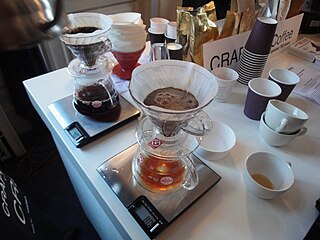
Coffee preparation is the process of turning coffee beans into liquid coffee. While the particular steps vary with the type of coffee and with the raw materials, the process includes four basic steps: raw coffee beans must be roasted, the roasted coffee beans must then be ground, and the ground coffee must then be mixed with hot or cold water for a specific time (brewed), the liquid coffee extraction must be separated from the used grounds, and finally, if desired, the extracted coffee is combined with other elements of the desired beverage, such as sweeteners, dairy products, dairy alternatives, or toppings.
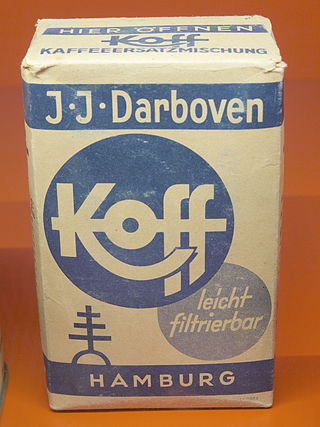
Coffee substitutes are non-coffee products, usually without caffeine, that are used to imitate coffee. Coffee substitutes can be used for medical, economic and religious reasons, or simply because coffee is not readily available. Roasted grain beverages are common substitutes for coffee.

Milk coffee is a category of coffee-based drinks made with milk. Johan Nieuhof, the Dutch ambassador to China, is credited as the first person to drink coffee with milk when he experimented with it around 1660.

Torrefacto refers to a particular process of roasting coffee beans, common in Spain, Paraguay, Portugal, Mexico, Costa Rica, Ecuador, Uruguay and Argentina. The process involves adding a certain amount of sugar during roasting in order to glaze the beans. By adding the additional sugar to the beans it increases the effects of the Maillard reaction during the roasting process, thus giving the beans more of that distinct flavor. The glazed beans are then mixed with normal roasted beans. While originally a cheap way of preserving the coffee beans in the 1920s, due to the common use of low-grade Robusta coffee the process was also used to hide negative aroma and taste characteristics of the coffee.
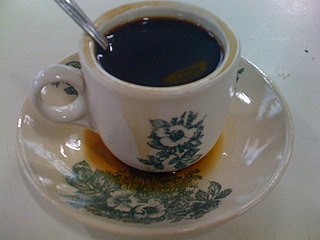
Kopi, also known as Nanyang coffee, is a traditional coffee beverage found in several Maritime Southeast Asian nations. Often brewed to be highly caffeinated in strength, it is commonly served with sugar and/or milk-based condiments. This drink originated from the British Malaya era, with Hainanese cultural roots. The name of the drink is derived from the Malay term for coffee. The term Nanyang, which means "South Sea" in Mandarin, refers to Maritime Southeast Asia. Kopi culture vocabulary is grounded in Hokkien dialect as a result of historical immigration to Maritime Southeast Asia from the Minnan region in the south-eastern part of Fujian Province in Southeastern Mainland China. The beverage is usually served in coffee shops, Hawker centres and kopitiams across the region.